What Are The Types of Different Horse Saddles?
Welcome, equestrian enthusiasts, to the fascinating realm of horse saddles! Dive into this guide, and you’ll soon appreciate the nuance and design of each saddle type. With their refined style, the English Dressage saddles are tailor-made for precise movements and grace.
On the flip side, the sturdy Western saddles are your reliable companions for rugged terrains and long rides, embodying durability and tradition. Then we have the sleek Racing saddles, engineered for speed and agility, ensuring the rider’s utmost security during those high-speed moments.
Don’t overlook the treeless saddles either; these offer a closer connection to the horse, ideal for those who prefer a more ‘intimate’ riding experience. And the sidesaddles? They pay homage to a bygone era, symbolizing elegance and a distinct riding technique.
As we journey through this guide, you’ll discover each type’s intricacies and unique applications. So, buckle up (or should we say, saddle up?), and let’s delve into horse saddles!
Western Saddles
Every Western saddle is like a page from a Wild West novel, echoing tales of cowboys and open plains. Crafted with love and tradition, their intricate designs narrate stories of adventures under vast skies.
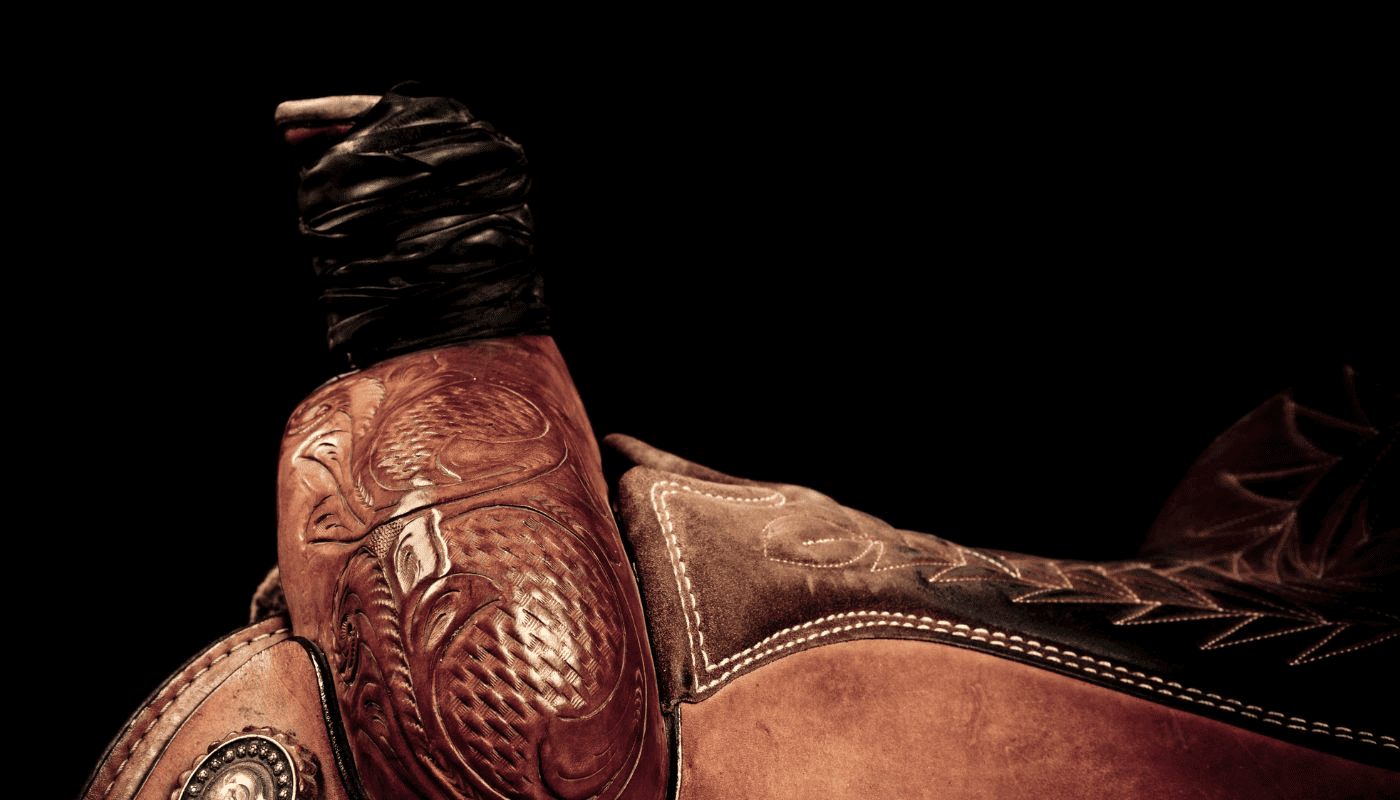
Their deep seats are not just for comfort but a gentle embrace, reminiscent of old tales told around a campfire. And for today’s spirited riders? The Western saddle is their steadfast companion, ready to embark on new journeys, whether a serene ride at dusk or a lively rodeo performance.
Cheers to the Western saddle, blending nostalgia with every modern gallop!
Roping Saddle
The roping saddle is a hallmark of equestrian craftsmanship, tailored to the demanding nuances of the rodeo arena. At its core is a robust tree, meticulously designed to withstand the intense pull and dynamic shifts synonymous with roping events.
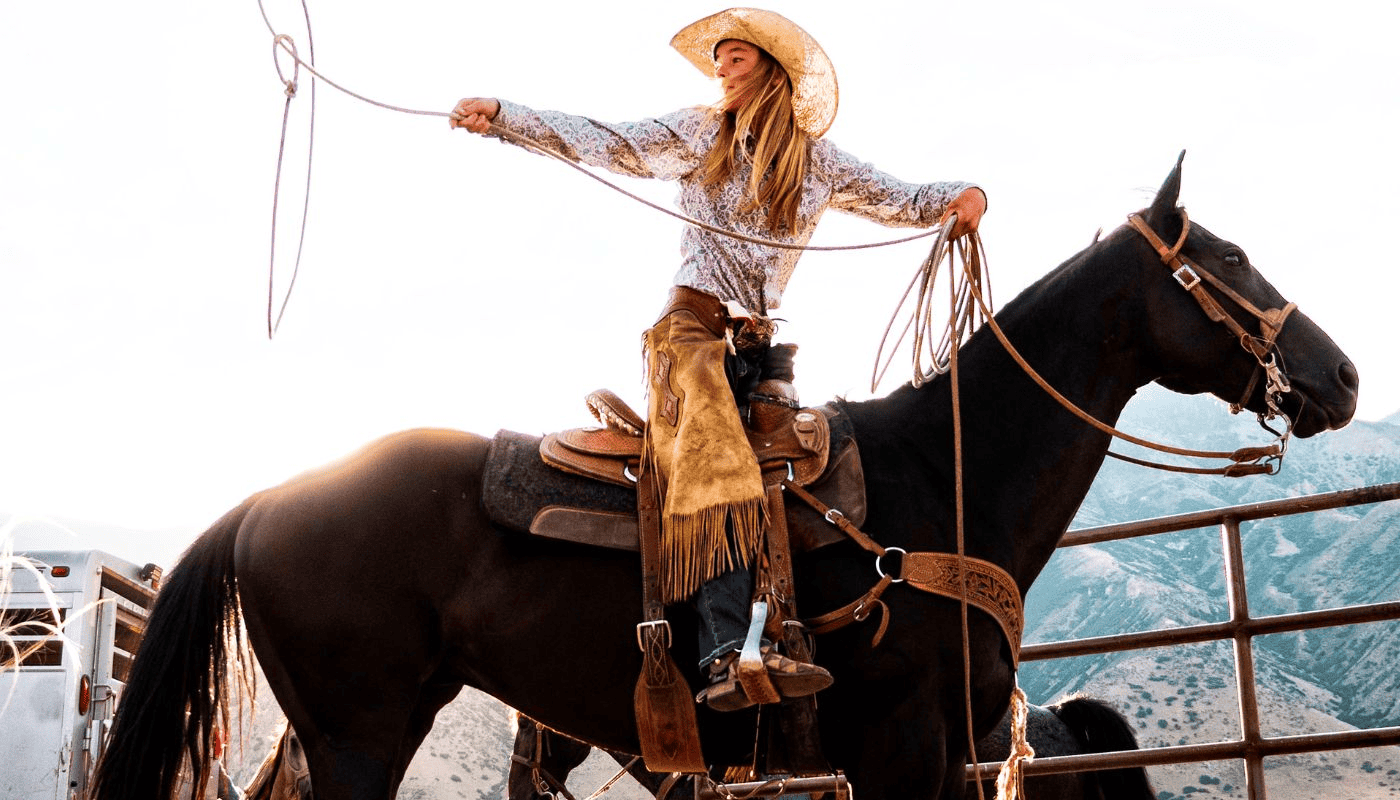
The pronounced horn isn’t merely an aesthetic touch; it’s instrumental, as a pivotal anchor when lassoing cattle. Here, the rope is securely fastened, ensuring precision and safety in the heat of the chase.
Further complementing the saddle’s architecture are expansive fenders and a deep seat, offering the rider protection and a secure embrace. Each element, from its intricate stitching to its strategic contours, works in concert, affording both horse and rider the reliability and comfort essential for the rigorous world of roping.
The roping saddle is a masterclass in design, melding functionality with an artistry that pays homage to timeless rodeo traditions.
Barrel Racing Saddle
Barrel racing saddles, revered artifacts within equestrian circles, are masterpieces tailored for the exhilarating dance around barrels at breakneck speeds. At the heart of their design lies a delicate balance between lightweight agility and steadfast support, ensuring that the horse and rider can execute swift, precise maneuvers without compromise.
Their skimmed-down profile, devoid of excess, allows for uninhibited movement, while the uniquely contoured seat nestles the rider, fostering an intimate connection with the horse beneath.

Reining Saddle
In the heart of the Wild West, where dust dances on the horizon and the spirit of the frontier lives on, a piece of equestrian craftsmanship embodies the essence of the untamed plains: the Reining Saddle. Crafted with care and an unwavering dedication to the art of horsemanship, this saddle is a masterpiece of form and function.
Trail Saddle
Nestled between the whispering leaves of ancient forests and the rugged terrain of untamed wilderness, the Trail Saddle stands as a steadfast companion to those seeking nature’s solace on horseback. It is more than just a piece of riding gear; it is a portal to adventure, a ticket to explore the hidden trails and secret glades of the great outdoors.
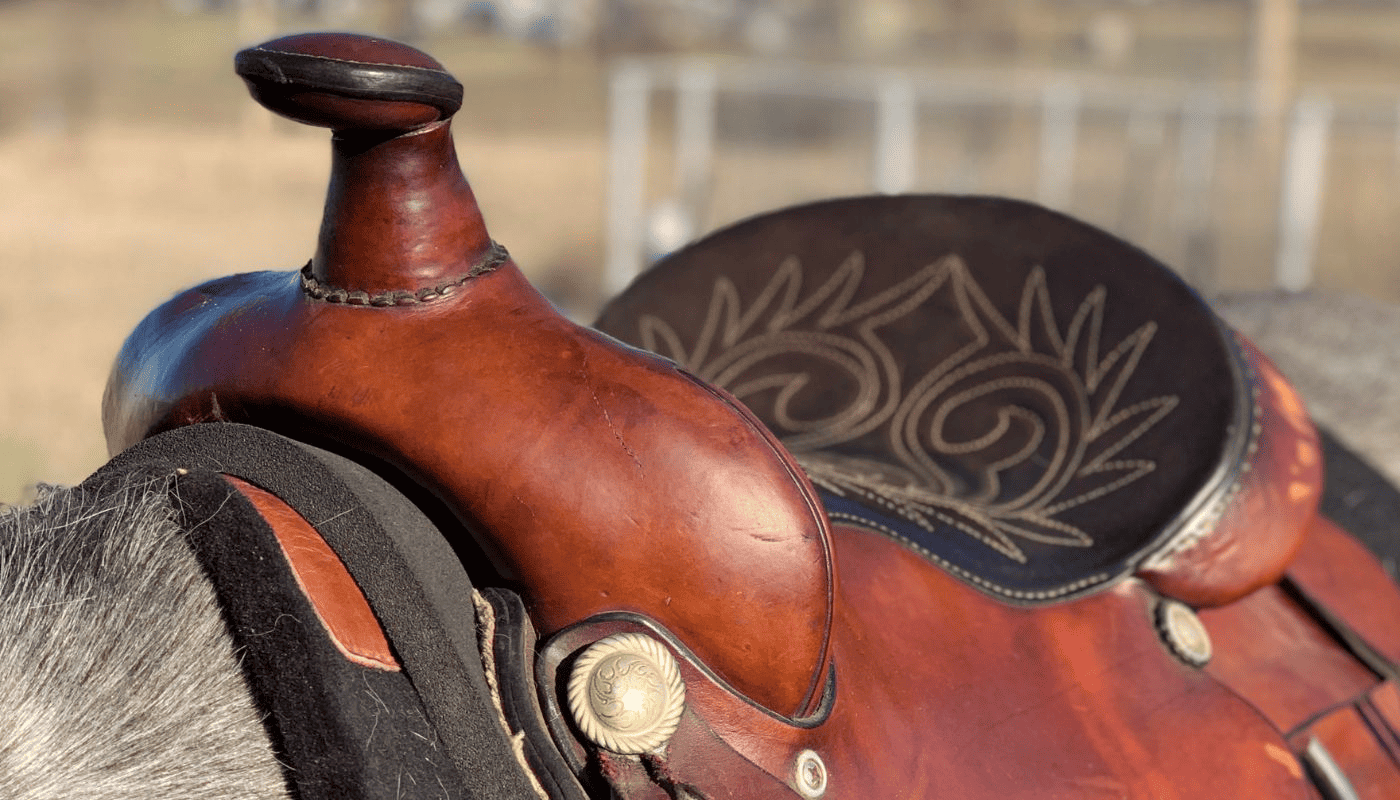
The saddle’s sturdy pommel and horn stabilize during treacherous descents and steep ascents. At the same time, its cushioned seat cradles the rider, allowing for hours of unhurried contemplation amid the beauty of the wilderness.
Beneath the saddle, the horse’s muscles ripple harmoniously with the undulating landscape, a living testament to the unspoken understanding between horse and rider. Together, they traverse the trails, forging bonds as strong as the leather that holds them together.
In the saddle’s creaking leather and the rhythmic beat of hooves against the earth, there is a timeless connection to nature, a reminder that in the heart of the wilderness, both rider and horse find freedom and communion with the world around them.
The Trail Saddle is not just a piece of equipment; it is the conduit to a world where every trail beckons with the promise of discovery and the thrill of the unknown.
Cutting Saddle
The Cutting Saddle, a specialized piece of equestrian equipment, plays a pivotal role in cutting horse competition. Designed with precision and functionality in mind, it facilitates the intricate and high-speed maneuvers required in this sport.
One of the critical features of a Cutting Saddle is its low-profile horn. This horn lets the rider maintain a secure grip while leaning forward to control the horse during the precision cuts. The saddle’s deep seat provides stability, ensuring that the rider remains securely in place even during the horse’s most agile and abrupt movements.
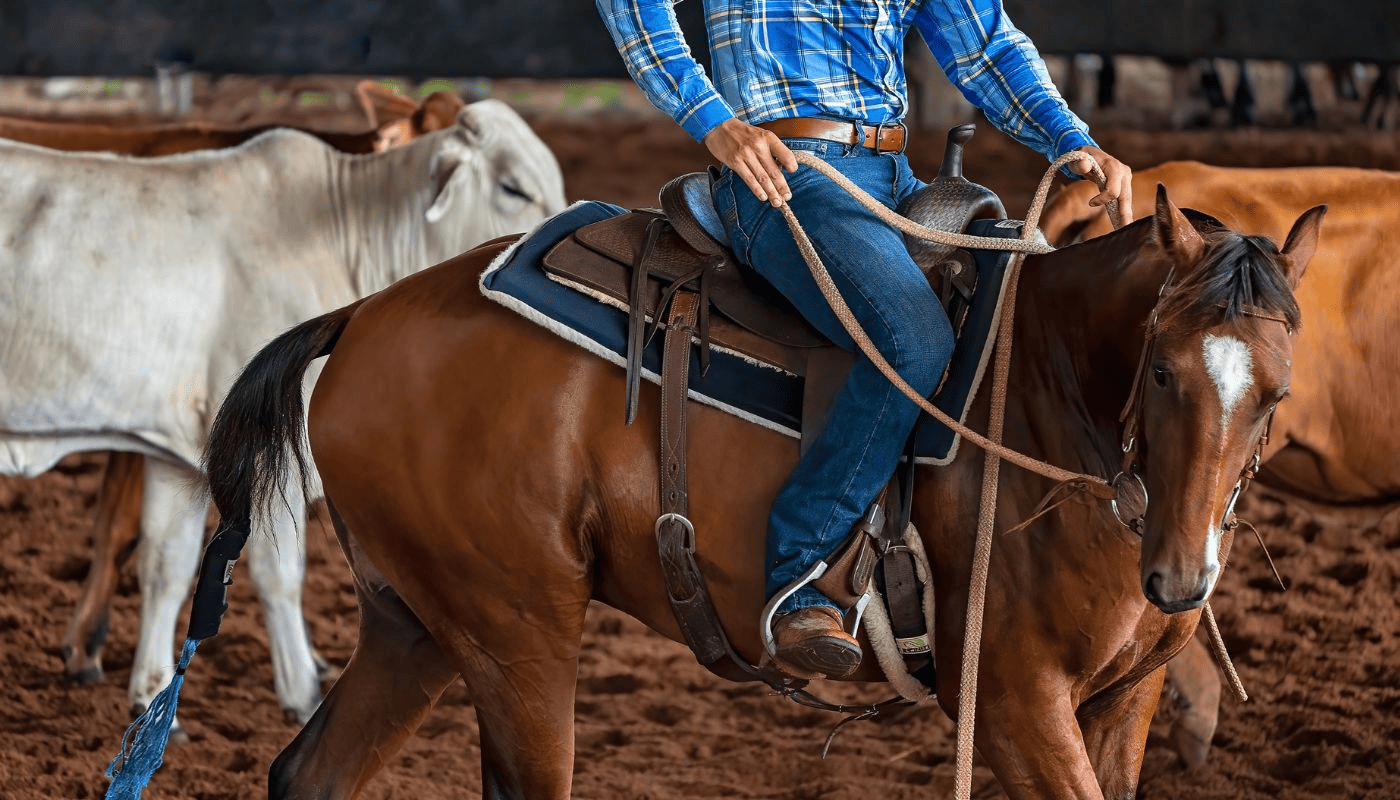
Cutting horses are trained to isolate a single cow from a herd and keep it separated. The Cutting Saddle aids in this endeavor by providing the rider with the necessary support and balance to execute rapid, controlled turns and movements. The rider and horse work in tandem, with the saddle acting as a critical interface that allows for seamless communication and precise execution of maneuvers.
In the competitive arena, the Cutting Saddle is not just a piece of equipment but an essential tool that enables riders to showcase their skills and the exceptional abilities of their horses. It represents the culmination of centuries of horsemanship and is a testament to the close bond between rider and horse in the thrilling world of cutting horse competition.
Ranch Saddle
The ranch saddle is a fundamental piece of equestrian equipment that serves as the backbone of working life on a ranch. Designed to focus on durability, functionality, and rider comfort, the ranch saddle is a steadfast companion for ranchers and cowboys who spend long hours in the saddle tending to livestock, herding cattle, and performing various ranch chores.
One of the distinguishing features of a ranch saddle is its sturdy construction. It typically has a reinforced tree made of wood or fiberglass, ensuring it can withstand heavy-duty ranch work’s rigors. The saddle’s leather is often rugged and built to last, able to endure exposure to the elements and the wear and tear of daily ranch activities.
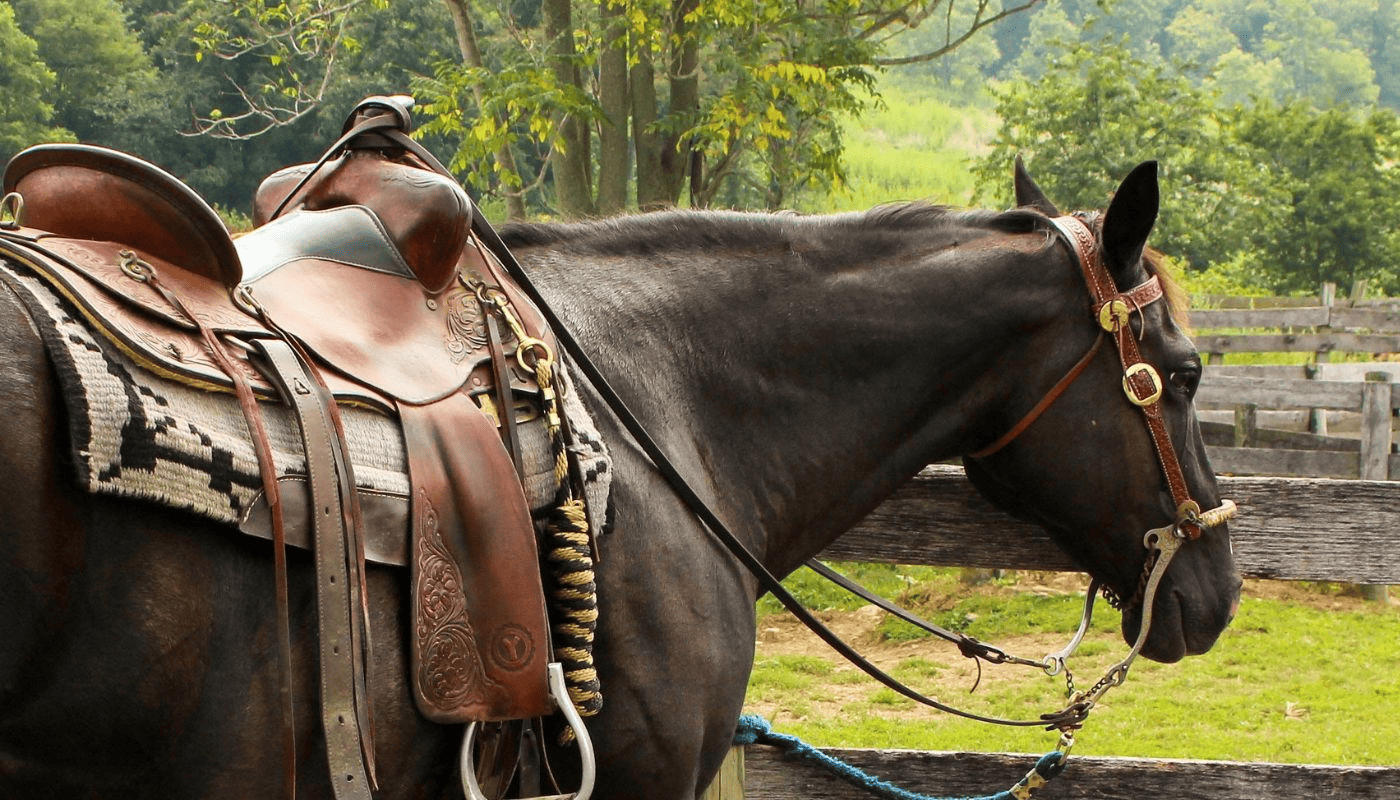
The design of a ranch saddle prioritizes rider stability and comfort. It usually features a deep seat that provides security and support during long hours in the saddle. The saddle’s horn, which can vary in size and shape, serves multiple functions, including securing ropes and offering stability during cattle roping and ranch tasks.
Ranch saddles come in various styles to suit different ranching needs, from all-around ranch saddles suitable for a wide range of tasks to specialized roping or cutting saddles designed for specific ranch duties. The ranch saddle is more than just equipment; it represents a way of life deeply intertwined with the land and the livestock, embodying the resilience and dedication of those who work the ranches of the American West.
Show Saddle
The show saddle is a meticulously crafted piece of equestrian equipment designed to make a bold statement in horse shows and competitions. These saddles are not just functional; they are works of art created to showcase the horse and rider in the most elegant and eye-catching manner possible.
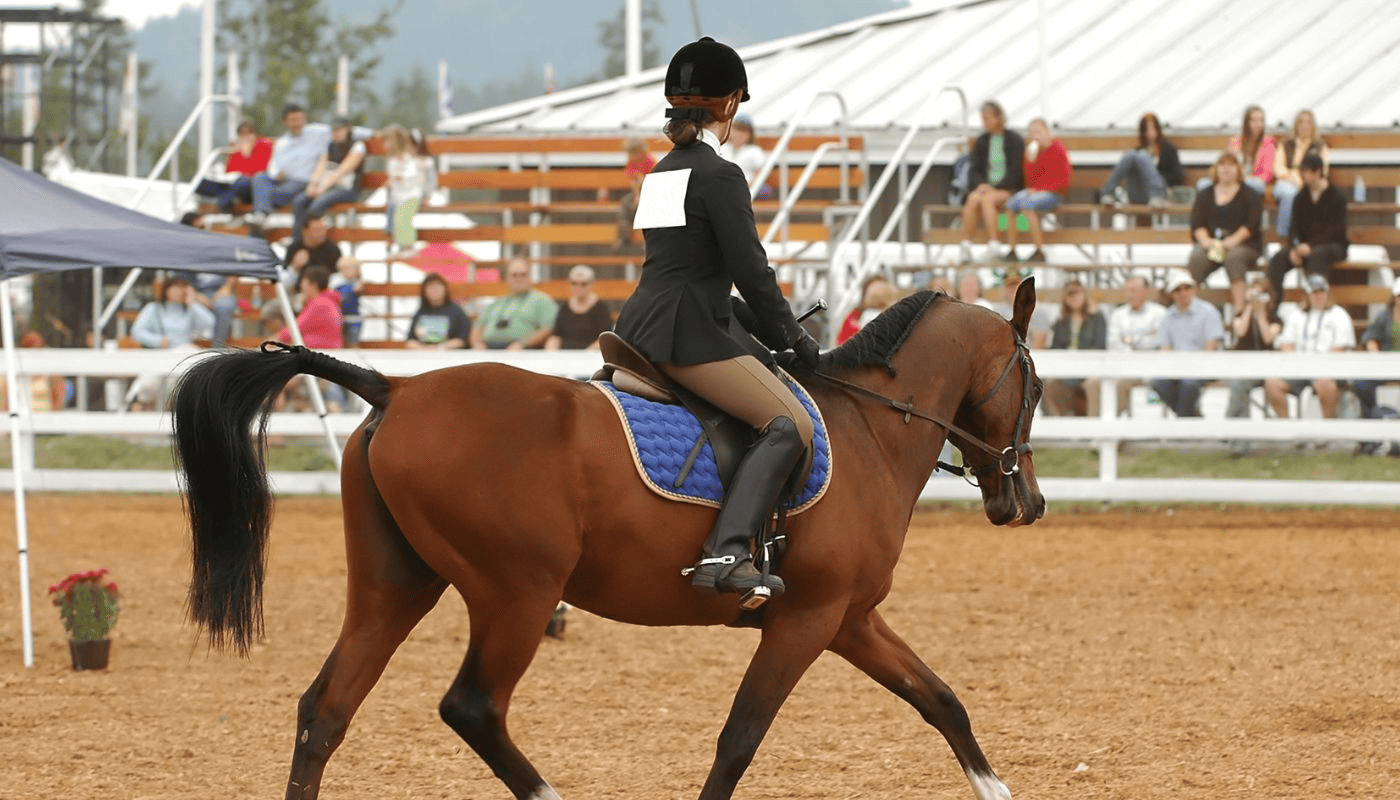
One of the defining features of a show saddle is its ornate and decorative design. Show saddles are often adorned with intricate tooling, silver accents, and ornamental elements that catch the light and draw attention to the rider. The leather in show saddles is typically of the highest quality, often hand-tooled to create intricate patterns and designs.
Show saddles are designed with rider comfort in mind, featuring a deep, cushioned seat that provides stability and support during the performance. The saddle’s stirrups are often adjustable to allow the rider to find the perfect position for their needs.
In addition to aesthetics, show saddles are designed to highlight the conformation and movement of the horse. They are typically lightweight and streamlined, allowing the horse to move freely and exhibit its grace and athleticism in the show ring.
Whether in Western pleasure, reining, or any other discipline, the show saddle symbolizes excellence and precision in the equestrian world. It represents the dedication of riders and the beauty of the horses they ride, making a lasting impression in the competitive arena.
Equitation Saddle
The equitation saddle, also known as an “equitation seat” or “close-contact saddle,” is a specialized piece of equestrian equipment designed primarily for riders participating in equitation classes or disciplines where rider position and form are paramount.
Unlike many other saddles, the equitation saddle strongly emphasizes promoting correct rider posture and balance, making it a valuable tool for riders aspiring to excel in equitation, hunter, and jumper competitions.
Equitation saddles are characterized by their minimalistic design, featuring a flat seat, shallow padded flaps, and a narrow twist. These features facilitate close contact between the rider and the horse, allowing for a heightened sense of feel and communication.
The flat seat encourages riders to maintain a balanced and centered position, while the shallow flaps enable riders to maintain close leg contact for precise cues.
One of the key distinctions of an equitation saddle is the absence of a horn, which is commonly found on Western saddles. This design choice allows for greater freedom of movement and flexibility for riders in English riding disciplines.
Equitation saddles come in various styles and materials, catering to individual rider preferences and the specific demands of different equitation events. They are an essential tool for riders striving to master the art of effective communication with their horses and showcase their skills and elegance in the competitive world of equitation and jumping.
English Saddles
The English saddle stands as an epitome of equestrian elegance. Its streamlined design champions precision and sophistication, setting it apart from other saddles. Its minimalist construction ensures close contact with the horse, facilitating a palpable harmony in every stride.
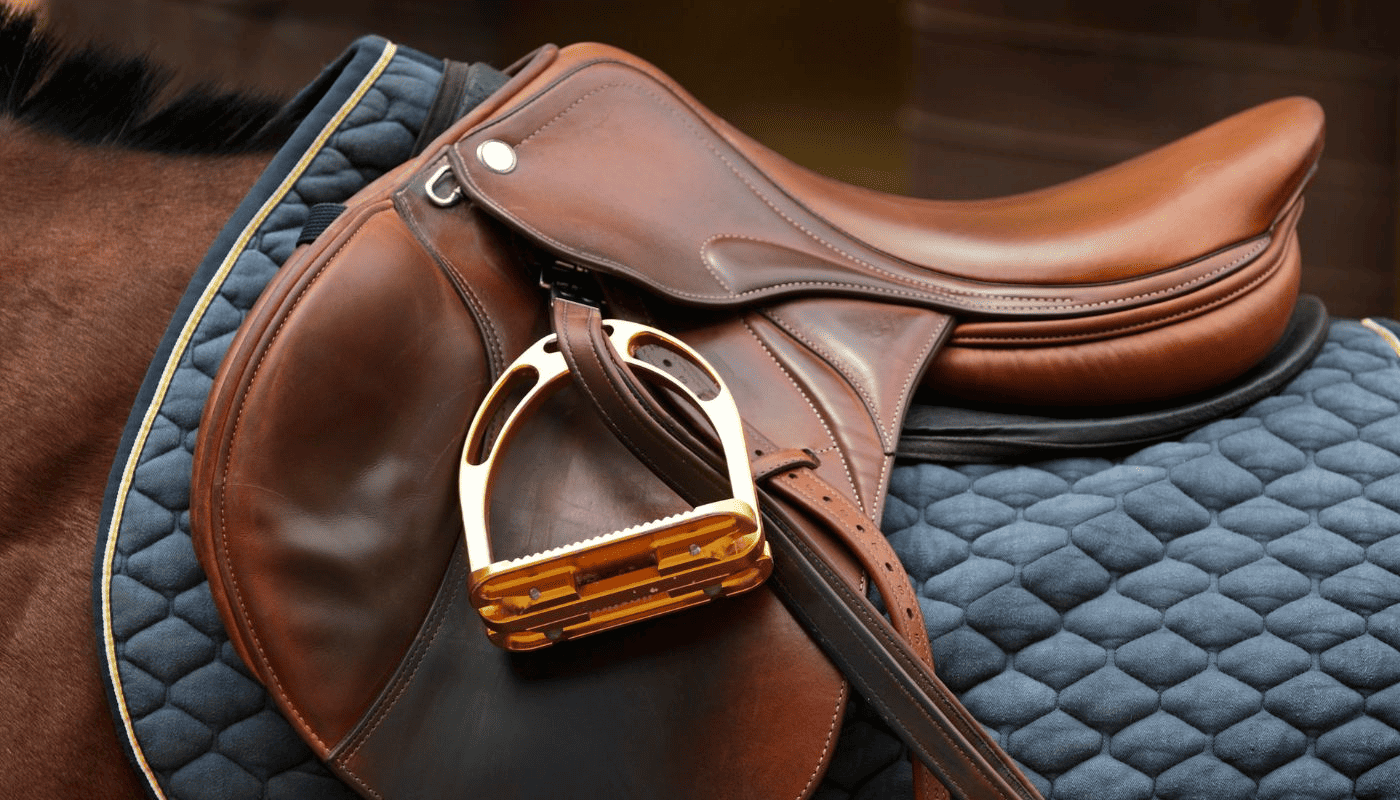
The English saddle isn’t just about riding; it’s about mastering the art of equine connection, making every journey a seamless dance of horse and rider. Choose the English saddle, and you’re choosing unparalleled finesse.
All-Purpose Saddle
All-purpose saddles, often called “AP saddles,” are versatile and well-rounded pieces of equestrian equipment designed to cater to a wide range of riding styles and disciplines. These saddles are popular among riders who engage in multiple riding activities, including flatwork, jumping, trail riding, and even light dressage.
The versatility of all-purpose saddles makes them a practical option for riders who prefer not to have a specialized saddle for each riding discipline.

Key features of all-purpose saddles include a moderately deep seat and forward-cut flaps. These design elements balance rider stability and freedom of movement, making them suitable for various riding activities.
The saddle’s knee and thigh blocks are typically adjustable or removable, allowing riders to customize their position and support based on their needs.
The design of all-purpose saddles allows riders to maintain a balanced and centered position, whether tackling jumps or going for a relaxed trail ride. The saddle’s versatility accommodates riders of different skill levels and body types, making it a practical choice for riders who share their saddle with multiple horses.
Materials and construction quality may vary among all-purpose saddles, with options ranging from basic models to higher-end designs with premium leather and additional features.
As a go-to option for riders looking for adaptability, comfort, and versatility, the all-purpose saddle remains a staple in the equestrian world, serving riders across various disciplines and riding experiences.
Dressage Saddle
The Dressage Saddle is a specialized piece of equestrian equipment designed to support the rider’s optimal position and provide precise aids for communicating with the horse during dressage competitions, a discipline known for its emphasis on precision, elegance, and harmonious rider-horse communication.

One of the defining features of a Dressage Saddle is its deep, straight-cut seat. This design encourages the rider to sit deeply and vertically, aligning the rider’s ear, shoulder, hip, and heel in a straight line. The long, straight flaps of the saddle allow for extended leg contact, facilitating subtle and refined cues from the rider to the horse.
Dressage Saddles typically have minimal padding beneath the rider’s seat, allowing for a close and sensitive connection with the horse’s back. Additionally, they often lack a prominent pommel or horn, ensuring that the rider’s aids are communicated exclusively through the seat, legs, and hands.
The Dressage Saddle’s design promotes rider stability and an effective position for executing precise movements and intricate dressage patterns. It aids in developing the rider’s seat and aids in achieving the harmonious partnership between horse and rider that is essential in dressage.
These saddles are available in various styles and materials to accommodate rider preferences and horse conformations. The Dressage Saddle remains an essential tool for riders dedicated to mastering the art of dressage and showcasing the grace and precision of this disciplined riding style in the competitive arena.
Jumping Saddle
The Jumping Saddle, an essential piece of equipment for equestrians engaged in show jumping, eventing, and other jumping disciplines, is meticulously designed to provide the rider with the stability and freedom of movement necessary to tackle obstacles with precision and grace.
These saddles are engineered to facilitate the rider’s ability to stay securely in the saddle while allowing the horse the freedom to perform powerful jumps.

Key features of a Jumping Saddle include a forward-cut flap, a more pronounced knee and thigh block, and a relatively flat seat. These elements enable the rider to maintain a balanced position when approaching and clearing jumps, providing greater security and control during the dynamic jumping movements.
The forward flap design accommodates the shorter stirrup length commonly used in jumping, allowing the rider to shorten their stirrups for a secure two-point position over jumps.
Jumping Saddles are typically lighter in weight compared to other saddles, reducing the overall burden on the horse during jumps. They also often feature a prominent, padded pommel to support the rider when going into a forward seat position during a jump.
Materials and construction quality vary among Jumping Saddles, with high-end models often crafted from premium leather and offering customizable features. These saddles are essential for riders seeking to excel in the demanding and thrilling world of jumping, where precision and harmony between rider and horse are paramount for success.
Hunting Saddle
The Hunting Saddle, also known as a “foxhunting saddle” or “cross-country saddle,” is a specialized piece of equestrian equipment designed to cater to the unique demands of fox hunting and cross-country riding. These saddles are tailored to provide riders stability, comfort, and security while navigating diverse terrains and obstacles during hunts and steeplechase events.
Key features of a Hunting Saddle include a moderately deep seat and a forward-cut flap. These design elements allow the rider to maintain a balanced and secure two-point or “half-seat” position when jumping over fences and navigating rough terrain. The saddle often features padded knee rolls and thigh blocks to provide additional support and stability, especially during high-speed chases.
Hunting Saddles are typically constructed with durability in mind, using robust materials and reinforced stitching to withstand the rigors of outdoor activities. They may also incorporate D-rings and attachments for hunting accessories, such as a sandwich case or a horn.
The design of the Hunting Saddle enables riders to comfortably and safely participate in the exhilarating sport of fox hunting, which involves traversing open fields, jumping obstacles, and following hounds. These saddles are also well-suited for cross-country riding and eventing, where riders and horses must navigate challenging courses, including natural obstacles, water crossings, and jumps.
Hunting Saddles are an integral part of the tradition and excitement of fox hunting, offering riders the tools they need to enjoy this age-old pursuit while ensuring the safety and comfort of both horse and rider during demanding outdoor adventures.
The Endurance Saddle is a specialized piece of equestrian equipment designed to accommodate the unique demands of long-distance endurance riding. This discipline requires riders and horses to cover vast distances, often over rugged terrain and challenging environmental conditions, while maintaining both the horse’s and rider’s comfort and stamina.
Endurance Saddle
Key features of an Endurance Saddle include a lightweight construction and a comfortable, cushioned seat. These design elements help reduce fatigue for both horse and rider during extended rides. The saddle typically has extra D-rings and attachments to secure trail gear, such as water bottles, saddlebags, and other essential supplies for long rides.
Endurance Saddles are built with ergonomics in mind, allowing riders to maintain a balanced position and distribute their weight evenly across the horse’s back. The saddle flaps are often designed to provide maximum contact with the horse’s sides while ensuring freedom of movement for the horse’s shoulders and back.
Materials used in Endurance Saddles may vary, but they are generally lightweight and breathable to prevent overheating and discomfort for the horse. The saddle tree provides ample clearance over the horse’s withers and spine to prevent pressure points and promote airflow.
These saddles are essential for riders participating in endurance riding competitions, which can cover distances ranging from 25 to 100 miles or more in a single day. The Endurance Saddle is designed to prioritize the health and comfort of both horse and rider during the demanding challenges of endurance riding.
Side Saddle
The Side Saddle, a unique and historic equestrian saddle, is designed specifically for women riders and is notable for its distinctive appearance and riding posture. It allows riders to sit sideways on the horse, with both legs draped over one side of the saddle, a style of riding that dates back centuries.
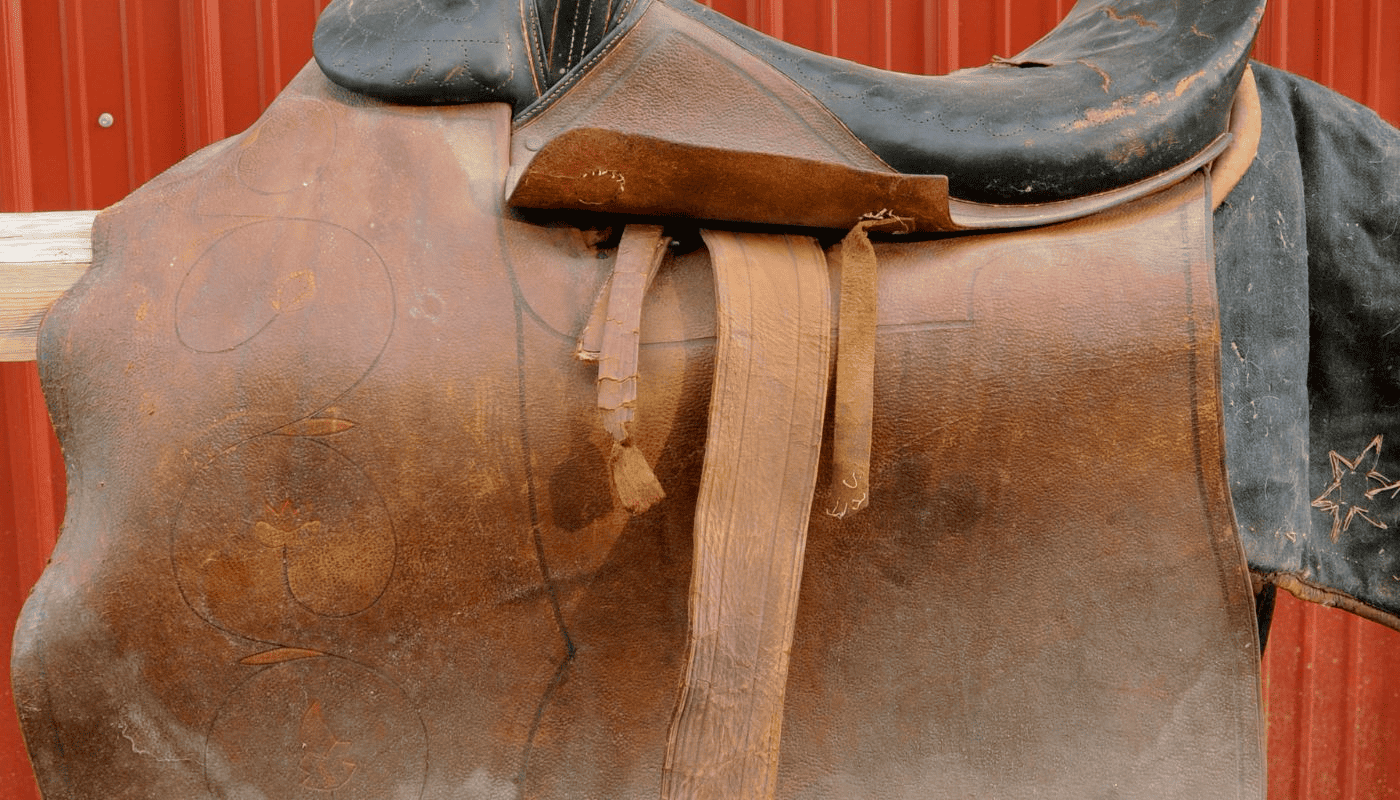
Key features of the Side Saddle include a deeply curved pommel and a leaping horn, which provide the rider with stability and support. The rider’s right leg rests in a padded stirrup, while the left leg is secured in a leather or webbing strap known as a “balance girth.” The saddle is constructed with a higher cantle to help the rider stay securely in place.
Riding side-saddle requires a unique riding posture, with the rider sitting tall and upright. This elegant and refined riding style was traditionally associated with formal events and fox hunting in the past, making the Side Saddle a symbol of tradition and etiquette in the equestrian world.
Modern Side Saddles are crafted with comfort and safety in mind, incorporating advancements in materials and design while preserving the classic appearance. Riders today may still choose to ride side saddle for various equestrian disciplines, including historical reenactments, dressage exhibitions, and side saddle competitions.
The Side Saddle continues to captivate riders with its unique and graceful riding style, representing a piece of equestrian history and the enduring elegance of women in the saddle.
Cross-Country Saddle
The Cross-Country Saddle, specifically tailored for the demanding sport of cross-country riding within the discipline of eventing, is a crucial piece of equipment designed to provide riders with stability, comfort, and security while navigating varied terrains and jumping obstacles during eventing competitions. Eventing combines dressage, cross-country, and show jumping into a challenging three-phase competition, making the Cross-Country Saddle essential for the exhilarating cross-country phase.

Key features of a Cross-Country Saddle include a forward-cut flap, padded knee rolls, and thigh blocks to assist riders in maintaining a secure position during high-speed gallops and while jumping obstacles. The saddle is constructed with durability in mind, using rugged materials and reinforced stitching to withstand the rigors of cross-country riding.
Cross-country saddles are lightweight and designed to reduce rider fatigue during extended rides, offering a comfortable, cushioned seat for long hours in the saddle. The saddle’s forward flap allows riders to maintain a two-point position while galloping and approaching jumps, providing better balance and control.
These saddles are also engineered to distribute the rider’s weight evenly over the horse’s back to prevent discomfort and ensure the horse’s well-being during strenuous cross-country phases. With the dynamic nature of cross-country riding, riders rely on their Cross-Country Saddle to provide safety and performance as they tackle challenging courses, including water crossings, ditches, banks, and solid jumps.
The Cross-Country Saddle is crucial in helping riders excel in the thrilling and demanding sport of eventing, ensuring that both horse and rider can confidently navigate the varied obstacles and terrains encountered during cross-country competitions.
Synthetic Saddle
The Synthetic Saddle, a modern alternative to traditional leather saddles, is crafted from synthetic materials such as nylon, fiberglass, and synthetic leather substitutes. These saddles offer several advantages, making them popular among riders across various disciplines.
A Synthetic Saddle’s primary benefits are its durability and resistance to the elements. Unlike traditional leather saddles, synthetics are highly moisture resistant and less prone to damage from rain or exposure to harsh weather conditions. They are also easy to clean and maintain, requiring minimal effort to keep them looking and performing well.
Synthetic Saddles are typically lighter, making them an excellent option for riders who prefer a lightweight saddle or for those who frequently need to lift and handle the saddle. Their lightweight construction can reduce the overall burden on the horse’s back, enhancing its comfort during long rides.
These saddles are also budget-friendly, often offering a more affordable alternative to their leather counterparts. Additionally, synthetic materials can be molded into various designs and shapes, allowing for innovative saddle designs that cater to specific riding disciplines and rider preferences.
Synthetic Saddles are a versatile choice for trail riding, endurance riding, or other equestrian activities where durability, ease of maintenance, and lightweight construction are essential. They have become a popular option for riders looking for practicality, comfort, and affordability without compromising on quality and performance.
Polo Saddle
The Polo Saddle, purpose-built for the fast-paced and physically demanding sport of polo, is a specialized piece of equestrian equipment designed to offer riders stability, control, and comfort during matches. Polo is known for its exhilarating horseback action, and the Polo Saddle plays a critical role in enabling players to excel in this dynamic sport.
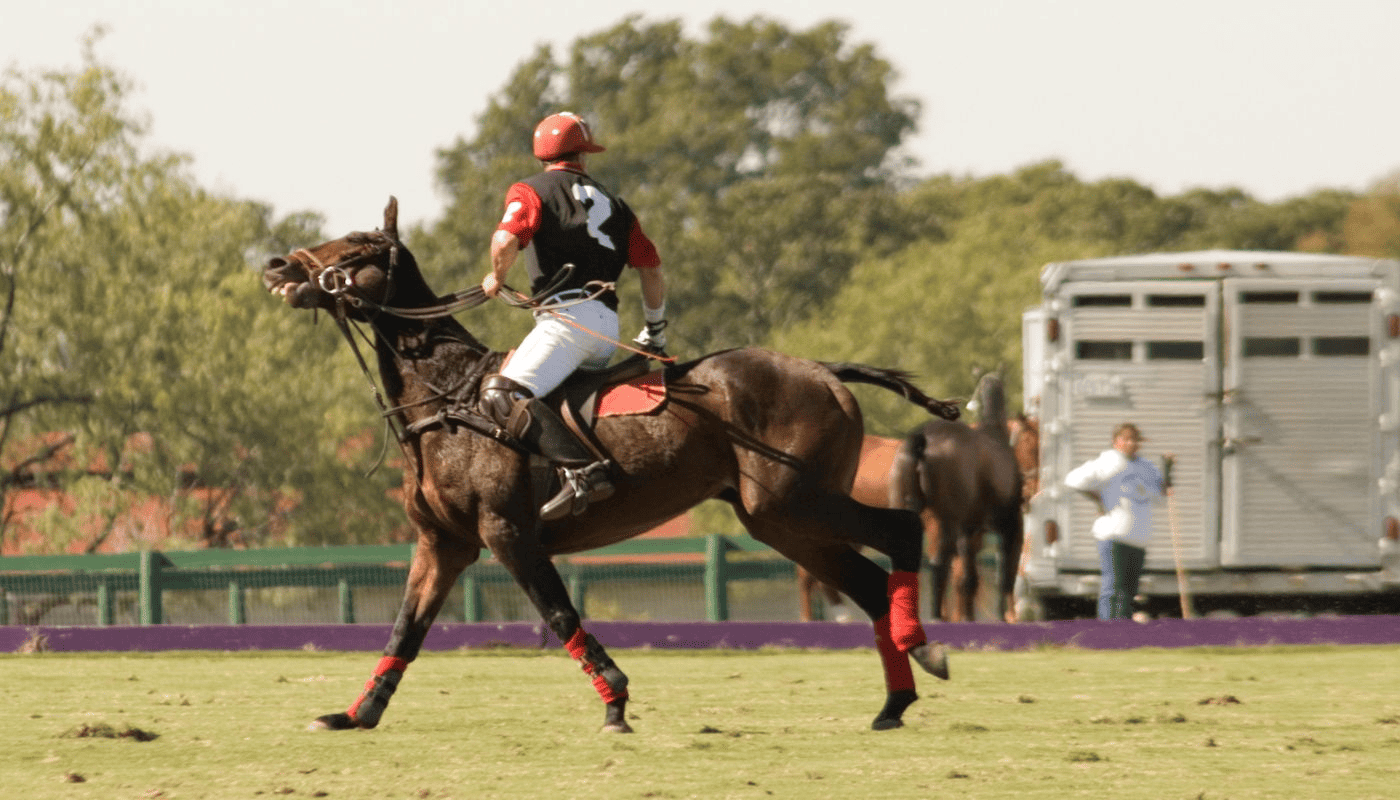
Key features of a Polo Saddle include a flat seat and low pommel, which allow riders to easily move and swing their mallets for striking the polo ball. The saddle is typically designed with minimal padding beneath the rider’s seat to provide a close and sensitive connection with the horse, allowing for precise communication and rapid maneuverability.
Polo Saddles often incorporate a prominent cantle and high-quality leather to withstand the rigors of the game, including frequent bumps and collisions between horses and players. Stirrups are designed to provide maximum stability while allowing for quick footwork.
The design of the Polo Saddle prioritizes the safety and security of the rider during the intense action of a polo match, allowing players to focus on their horsemanship skills and ball-handling abilities.
These saddles are available in various styles and materials to suit player preferences and needs, making them an essential tool for those who participate in the thrilling world of polo, where teamwork, precision, and horsemanship come together in a fast-paced and competitive arena.
Specialized Saddles
Specialized saddles are like the bespoke tailoring of the equestrian world. Crafted with precision and attention to detail, they cater to the unique needs of both horse and rider. Whether addressing a horse’s specific build or accommodating a rider’s requirements, these saddles are designed for a custom fit.
The result? An enhanced riding experience, ensuring comfort, balance, and optimum performance. When you choose a specialized saddle, you’re investing in tailored excellence for every ride.
Treeless Saddle
The Treeless Saddle is an innovative departure from traditional saddles, known for its unique design that lacks a rigid internal tree structure. Instead, it relies on soft padding and flexible materials to conform to the horse’s back, providing a close and comfortable fit. This saddle style has gained popularity among riders who seek a more natural riding experience and a closer connection with their horse.
One of the primary advantages of a Treeless Saddle is its flexibility, allowing it to mold to the horse’s shape, promoting even weight distribution, and reducing pressure points. This design is especially appealing for horses with unique conformation or those sensitive to traditional saddles.
Treeless Saddles often provide closer contact between the rider and the horse, enhancing communication and feeling. Riders appreciate the increased flexibility of movement, making it easier to maintain a balanced seat and adapt to the horse’s movements, particularly during disciplines like dressage or trail riding.
However, it’s essential to note that treeless saddles may not be suitable for all riding disciplines or all horses. Some riders lack the necessary support and stability for activities such as jumping or roping. Proper fitting and padding are crucial to ensure that the saddle distributes weight evenly and does not cause discomfort to the horse’s back.
In summary, Treeless Saddles offers a unique riding experience, favoring flexibility, comfort, and a closer connection between rider and horse. Riders seeking a more natural and adaptable saddle option may find the treeless design suitable for their equestrian pursuits.
Endurance Saddle
The Endurance Saddle is a specialized saddle designed to meet the rigorous demands of long-distance endurance riding, where riders and horses cover extended distances over various terrains while maintaining comfort, stability, and performance. This type of saddle is tailored to the specific needs of endurance riders, who often compete in races that can span 25 to 100 miles or more in a single day.
Key features of an Endurance Saddle include a lightweight construction, a cushioned seat, and a streamlined design. These elements aim to minimize rider fatigue and ensure comfort during prolonged rides. The saddle typically features multiple D-rings and attachment points for securing necessary equipment such as saddlebags, water bottles, and trail gear.
The design of Endurance Saddles prioritizes the well-being of both horse and rider. They distribute the rider’s weight evenly over the horse’s back to minimize pressure points, and their shape allows for freedom of movement in the horse’s shoulders and spine.
Materials used in Endurance Saddles vary, but they are generally chosen for their lightweight, breathable, and easy-to-maintain qualities. These saddles are indispensable for riders participating in endurance riding competitions, providing the necessary support, comfort, and durability required for covering vast distances in challenging conditions while maintaining the health and performance of the horse.
Plantation Saddle
The Plantation Saddle is a distinct type of equestrian saddle designed for the comfortable, leisurely riding experience often associated with plantation life in the American South. It is characterized by its unique shape and features, making it well-suited for long hours of relaxed riding, trail riding, and endurance riding.
Key features of a Plantation Saddle include a deep, comfortable seat, extra padding, and a prominent pommel. These design elements provide a secure and comfortable position, ensuring riders can spend extended periods in the saddle without discomfort. The saddle typically lacks knee rolls or thigh blocks, allowing for greater freedom of movement for the rider.
The Plantation Saddle’s design also focuses on the horse’s comfort. It features a wide tree and ample weight distribution to minimize pressure points on the horse’s back. The saddle’s flared, rounded skirts provide additional stability and even weight distribution.
Plantation Saddles are commonly associated with gaited horse breeds, such as Tennessee Walking Horses or Missouri Fox Trotters, as the design allows these breeds to showcase their smooth, natural gaits. Riders who enjoy long hours of trail riding and relaxed outings often favor the comfort and security provided by a Plantation Saddle.
While the Plantation Saddle has historical ties to the American South, it remains a popular choice among riders who seek a comfortable and practical saddle for extended, leisurely rides through scenic landscapes.
Australian Stock Saddle
The Australian Stock Saddle, often called the “Aussie Saddle,” is a distinctive and highly functional saddle design that deeply roots Australia’s cattle and ranching traditions. Developed to cater to the demanding needs of stockmen and drovers in rugged Australian terrains, this saddle is a unique fusion of Western and English saddle features, making it ideal for long hours of cattle work, trail riding, and even endurance riding.
Key features of an Australian Stock Saddle include a deep, comfortable seat, high cantle, and knee pads or poleys, which are knee rolls designed to provide added security and stability during cattle work and challenging terrain. The saddle often incorporates a horn for securing ropes, which is essential for cattle handling.
One of the hallmark features of the Aussie Saddle is its versatility. It allows riders to comfortably perform various tasks, from herding cattle and traversing uneven terrain to navigating long-distance trails. The saddle’s design promotes rider balance and security, which are critical when dealing with unpredictable livestock.
Materials and construction quality can vary among Australian Stock Saddles, but they are typically crafted with durability in mind. High-quality leather, reinforced stitching, and sturdy rigging are common features, ensuring the saddle’s longevity in demanding environments.
The Australian Stock Saddle is an essential tool for riders in Australia and beyond, offering a comfortable and secure option for various equestrian activities while honoring the rich heritage of Australian ranching and cattle work.
Military Saddle
The Military Saddle is a specialized equestrian saddle designed for the unique demands of military cavalry and mounted infantry units. With a history dating back centuries, these saddles were developed to provide the utmost comfort and functionality for soldiers on horseback, enabling them to perform a wide range of tactical maneuvers and duties effectively.
Key features of a Military Saddle include durability, simplicity, and versatility. These saddles are constructed to withstand the rigors of military service, often featuring reinforced leather, sturdy rigging, and minimalistic design elements. Their ruggedness ensures they endure long marches, field operations, and combat situations.
The Military Saddle is designed with a secure and balanced seat, allowing soldiers to ride comfortably over long distances and during extended periods of time. It typically includes attachment points for carrying essential gear, such as weapons, ammunition, and supplies.
Historically, various military organizations and nations have had their own versions of the Military Saddle, adapted to suit their specific needs and preferences. Some designs incorporated high pommels and cantles for added security during cavalry charges, while others favored a more streamlined and lightweight design for mounted infantry.
While the use of horses in military operations has diminished with modern technology, the legacy of the Military Saddle endures as a symbol of the cavalry’s historical significance and the critical role these saddles played in the military’s effectiveness in the past. Today, military saddles are mostly used for ceremonial and historical reenactment purposes.
Bareback Pad
A Bareback Pad, also known as a bareback riding pad or bareback saddle pad, is a simple and lightweight piece of equestrian equipment for riding a horse without the traditional saddle. It provides a cushioned barrier between the rider’s seat and the horse’s back, offering comfort and grip while maintaining a close and direct connection.
Key features of a Bareback Pad include a cushioned top surface made of materials such as foam, fleece, or synthetic materials like neoprene. This padding provides rider comfort and helps distribute the rider’s weight more evenly across the horse’s back, reducing pressure points.
Most Bareback Pads come with adjustable girth straps or cinches to secure the pad in place and prevent it from shifting during riding. Some may also have handles or handholds to help the rider maintain balance.
Bareback Pads are popular among riders who prefer a more natural and intimate riding experience. They are often used for casual riding, trail riding, and activities where the rider wants to feel the horse’s movements more directly. They can also be useful for riders looking to improve their balance and seat as they provide a closer connection with the horse’s body.
While Bareback Pads offer a comfortable and unencumbered riding experience, it’s important to use them carefully and ensure proper fitting to avoid discomfort or harm to the horse’s back. Riders should also be mindful of the type of riding they intend to do, as Bareback Pads may not provide the same support or stability as traditional saddles for more intense riding activities.
Racing Saddle
The Racing Saddle, an essential piece of equipment in horse racing, is designed with utmost attention to weight, balance, and functionality to maximize the horse’s speed and performance on the racetrack. These specialized saddles have evolved over centuries, tailored to the unique requirements of thoroughbred racing, harness racing, and other competitive equine sports.

Key features of a Racing Saddle include its lightweight construction, minimalistic design, and forward-cut seat. The saddle is meticulously crafted to minimize weight, with a lightweight tree and minimal padding to reduce unnecessary load on the horse’s back. The forward-cut seat allows the jockey to crouch into a low racing position while maintaining a balanced and secure seat.
Racing Saddles are typically devoid of the knee rolls and padding found in other saddles, as they prioritize close contact between the rider and the horse’s back, allowing for maximum freedom of movement. Stirrups are often short and designed to give the jockey added stability during high-speed races.
The design and materials of Racing Saddles continue to evolve with advances in technology and materials science, with the goal of enhancing both rider comfort and horse performance. These saddles are instrumental in horse racing, where fractions of a second can make the difference between victory and defeat and where the bond between rider and horse is essential for success on the racetrack.
Police Saddle
The Police Saddle, a patrol saddle or law enforcement saddle, is a specialized piece of equestrian equipment designed for use by mounted police officers and law enforcement agencies. These saddles are crucial in various aspects of police work, including crowd control, community policing, search and rescue missions, and event security.
Key features of a Police Saddle include durability, security, and functionality. These saddles are built to withstand the rigors of daily use and the demands of police work. They are often constructed with reinforced leather, sturdy rigging, and heavy-duty hardware to ensure longevity.
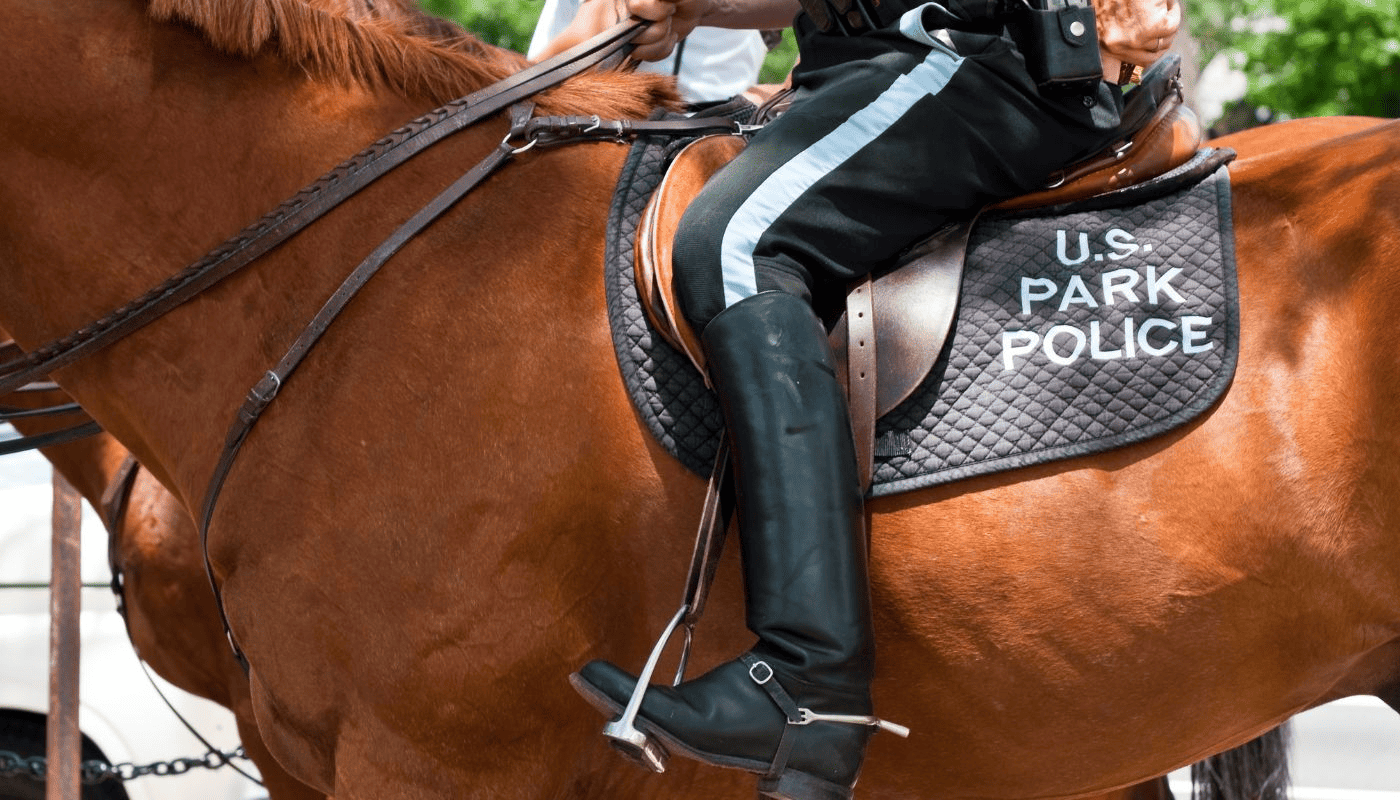
Security features may include a prominent pommel or horn for attaching equipment such as radios, batons, and other essential tools. Additionally, these saddles may incorporate D-rings and attachment points for securing items like saddlebags, first-aid kits, and even firearms holsters.
Police Saddles are designed to provide stability and security for the rider during various law enforcement activities, such as crowd management and rapid response. They often have deep seats, secure stirrup attachments, and extra padding to ensure rider comfort during extended shifts.
The design of Police Saddles also considers the horse’s safety and well-being. These saddles typically provide even weight distribution and ample clearance over the horse’s withers to prevent pressure points and discomfort.
Police Saddles play a crucial role in law enforcement, providing officers with the necessary tools and comfort to perform their duties effectively while mounted on horseback, ensuring public safety, and maintaining a visible and approachable police presence in the community.
Youth Saddle
A Youth Saddle is a specialized equestrian saddle designed specifically for young riders, typically children and teenagers, who are still developing their riding skills and may be smaller in stature compared to adult riders. These saddles are crafted to provide young riders comfort, stability, and safety as they embark on their equestrian journey.
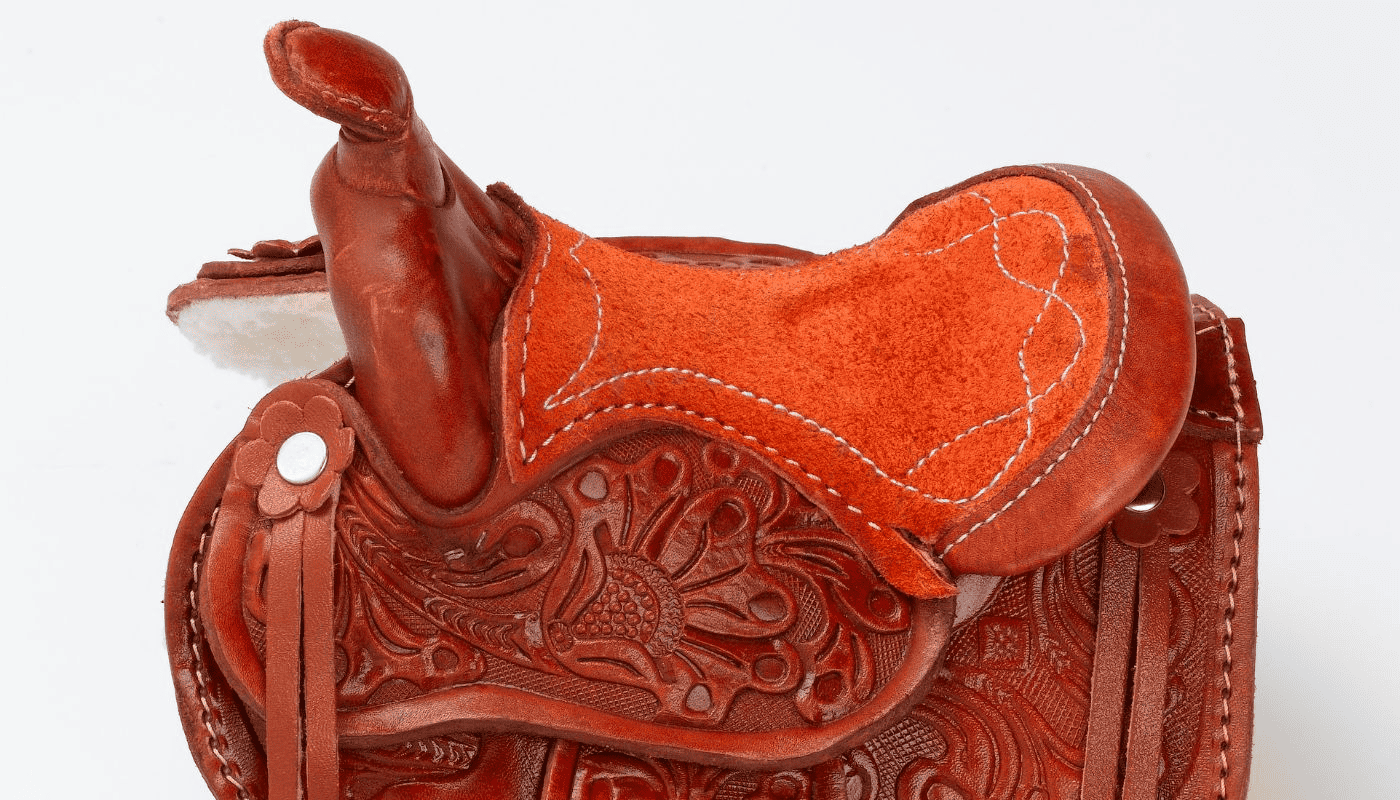
Key features of a Youth Saddle include a smaller seat size and shorter stirrups than adult saddles, which accommodate the shorter legs and smaller frames of young riders. The saddle is designed to promote proper rider positioning and balance, which is essential for young riders learning to control and communicate with their horses.
Youth Saddles often come with additional safety features, such as extra padding, secure stirrup attachments, and grab handles, which provide added stability and security for young riders as they gain confidence in the saddle. These features help reduce the risk of accidents and falls, making the riding experience safer and more enjoyable for young equestrians.
Materials and construction quality may vary among Youth Saddles, with some offering lightweight options for easy handling by young riders and others built with durability to withstand the demands of riding activities.
Overall, Youth Saddles is instrumental in introducing young riders to the world of horsemanship, ensuring their safety and comfort. At the same time, they develop their riding skills and build a lifelong love for horses and equestrian sports.
Conclusion
In conclusion, the world of equestrian sports and activities is rich and diverse, as are the types of horse saddles designed to cater to various riding disciplines and rider preferences. From the Western Saddle’s rugged and iconic design to the elegant and specialized Dressage Saddle, each type of saddle serves a unique purpose and offers specific features tailored to the demands of its respective riding discipline.




